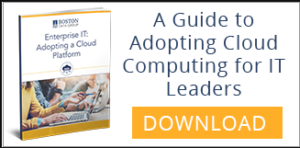Migrating to the Cloud: 4 Tips for Beginners
If you’re a business professional, you already know all too well the lightning pace at which IT is evolving. Yesterday’s cutting edge IT infrastructure is today’s antique computing platform, politely referred to as a “legacy system.” And while costs for in-house systems can remain high, performance can quickly degrade to low.
That’s why it seems everyone is moving to the cloud. Proprietary, on premise systems and datacenters are rapidly being replaced by cloud-based software-as-a-service (SaaS) and infrastructure-as-a-service (IaaS).
The exploding growth of Big Data is driving a parallel demand for larger, more flexible and scalable datacenters which can quickly escalate costs and resource consumption. As a result, enterprises of all sizes are switching to cloud-based IT ecosystems to avoid getting stuck with the slow-to-grow, heavy iron of an in-house infrastructure. Think of migrating to the cloud as an insurance policy against obsolescence.

- Assess everything
For many organizations, the first question is “are we ready to move to the cloud?” To answer that, firms need to assess three basic elements: people, technology, and process:
People First and foremost, do you have buy-in from all the stakeholders, including management and the workers who will need to utilize the cloud-based system? Many companies find that moving to the cloud changes how they do business and some managers and workers are inherently resistant to change. Often it’s a matter of including adequate preparation and investing the time and effort needed to educate everyone on what the move entails and the benefits that will result from it. Simply mandating change does not guarantee success. Starting small with a successful pilot can earn the buy-in of key team members.
Technology Infrastructure assessment starts with understanding the pluses and minuses of the current premise system. What works and what doesn’t? How does it work and why? With a clear picture of current capabilities and drawbacks you can better qualify the cloud structure you’ll need to not only carry over the capabilities of the current infrastructure but enhance and add to them.
Process Moving to the cloud is not so much a technological challenge as it is a process-based one. Enterprises need to assess and qualify their business and operational processes for cloud-readiness. Is there anything about your legacy system that prevents its functionality from moving to the cloud? Is data security an issue? Where are all your users located and how do you optimize cloud design for access and performance? How will moving to the cloud affect business continuity plans and redundancy?
- Choose a cloud consulting firm
An experienced cloud consulting firm can help you with the assessment process and assist you in your migration through a range of services. A firm with the right expertise can help you develop a strategy to seamlessly migrate and integrate your systems and data safely in the cloud. You may also choose to engage them in developing a pilot, training staff, or migrating key applications. While your existing MSP may tout skills in this arena, their approach will be more operational than strategic in nature and they may lack the inner knowledge of software development key to successfully migrating legacy applications.
- Develop a cloud migration strategy
Once you’ve selected a consultant, it’s time to roll up your sleeves and work with them to assess the value vs. cost/risk of transitioning from an in-house infrastructure to a cloud-based one. Your consultant should be able to help you develop a pilot and any proof-of-concepts to ensure that your migration will progress smoothly, starting with any low-hanging fruit that can provide the greatest opportunity for success and help build in-house enthusiasm for the move.
- Business continuity: have a back-up plan
Businesses run on data. Any disruption to the flow or integrity of that data can put operations – and an organization’s very existence – at risk. The cloud affords new approaches to security and business continuity – be sure to assess and adopt a new model. Done right, your data should be more secure and your applications more fault-tolerant.
There you have it. Four basic tips that can make migrating to the cloud as easy as possible. Whether you move all your primary business and operational functionality to the cloud or just a few, key processes, chances are you’ll reap significant benefits in streamlining and maintaining your IT ecosystem. You’ll save money and free up internal resources no longer needed to maintain a premise-based infrastructure while adding the flexibility and scalability you need to succeed.
For those who are contemplating a move to the cloud, our eBook titled A Guide to Adopting Cloud Computing for IT Leaders may be of interest. Of course, you may always reach out to Boston Data Group for a personalized discussion about the economics of migrating your IT infrastructure to the cloud.
Image Copyright: 123RF Stock Photo

